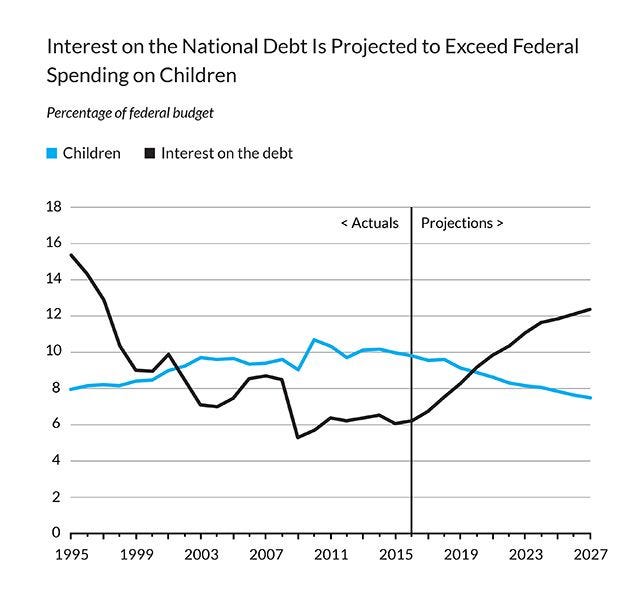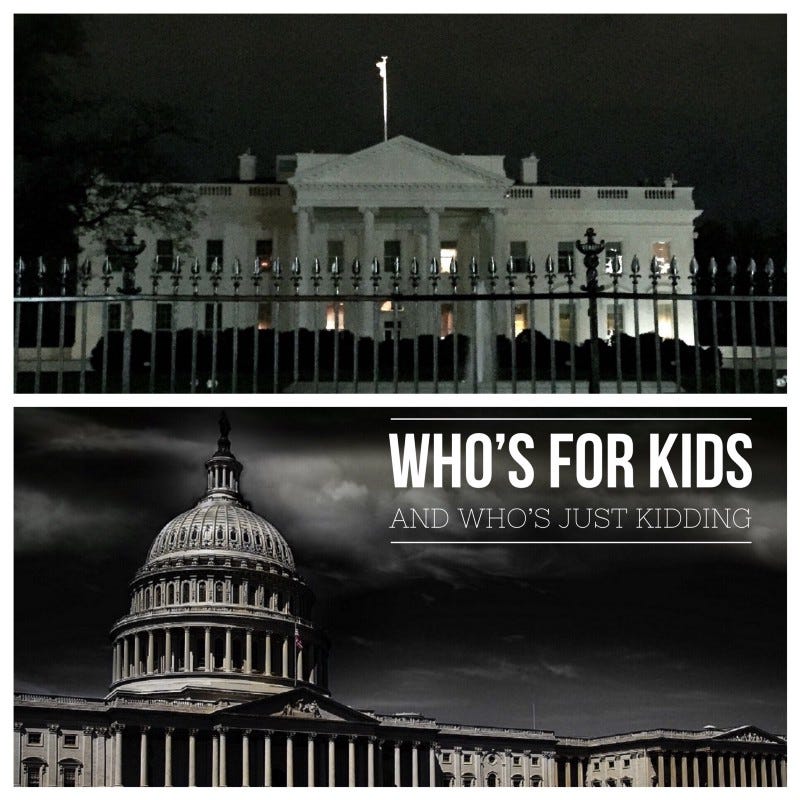Our nation’s children will be competing in a global economy and we must be preparing them for that future.
As Maya MacGuineas with the Committee for a Responsible Federal Budget writes in a recent Op-Ed in The Hill:
Globalization, technological advancements and the changing nature of work mean that the next generation will face a very different economy than the one we have experienced.
As the world changes in ways that will be nothing short of dramatic, it is more important than ever that we make necessary investments in human capital, otherwise known as … our kids.
Yet, our budget decisions reflect the opposite priorities where we are less focused on giving our nation’s youth the tools they will need, and instead are dangerously willing to leave them a legacy of debt.
Economists at the Hoover Institution made a similar point in the Washington Post this week. They argued:
We live in a time of extraordinary promise. Breakthroughs in artificial intelligence, 3D manufacturing, medical science and other areas have the potential to dramatically raise living standards in coming decades. But a major obstacle stands squarely in the way of this promise: high and sharply rising government debt.
If we wish to meet these opportunities and challenges, we must invest in an opportunity agenda that will give our kids the ability to be successful. Unfortunately, we are failing our kids. As MacGuineas explains:
Despite the needs of the youngest population and the economic benefits of investing in future generations, federal spending on children comprises a startlingly small and declining share of the federal budget.
In fact, data from Children’s Budget 2017 confirms that the federal share of spending on children has declined from 8.20 percent in 2014 to just 7.75 percent in 2017.

Meanwhile, projections by the Congressional Budget Office (CBO) find that our national debt will grow dramatically over the next decade and approach 100 percent of Gross Domestic Product (GDP) by 2028. Rather than investing in our nation’s children, science, and infrastructure, our nation will be racking up enormous deficits and putting the burden of paying that debt on the back of the next generation.
As the deficit rises and interest payments grow, this can create a “debt spiral” in which additional spending on the debt service continues to rise and further squeezes out investments in children, including education, early childhood, child abuse prevention, health care, and efforts to reduce child poverty.
In fact, the Urban Institute estimates that the share of federal spending on children will decline by nearly 25 percent over the course of the next decade. In its report entitled Kids’ Share 2017, the Urban Institute finds, “Over the next decade, every major category of spending on children (e.g., health, education, and income security) is projected to decline relative to GDP.”
We must do better by our children. In the end, it is all about our values, our priorities, and math.
According to CBO:
As interest rates return to historically higher levels and federal debt continues to mount, net outlays for interest are projected to jump significantly, increasing by 1.5 percentage points and nearly doubling as a share of the economy (from 1.6 percent of GDP to 3.1 percent) by 2028. . . CBO estimates that outlays for net interest will increase from $263 billion in 2017 to $316 billion (or 1.6 percent of GDP) in 2018 and then nearly triple by 2028, climbing to $915 billion. As a result, under current law, outlays for net interest are projected to reach 3.1 percent of GDP in 2028 — almost double what they are now.

These budget projections will have enormous consequences for our children and our nation’s future. As an example, the Urban Institute estimates that federal spending on interest payments would exceed spending on children by 2020.

As bad as that chart looks for children, Urban’s estimate actually understates the problem because it was made before passage of the tax bill this past December. Making matters worse, CBO projects that the tax bill will cause federal revenues to decline as a percentage of the GDP from 17.3 percent in 2017 to 16.6 percent in 2018, which is “below the average of 17.4 percent of GDP recorded over the past 50 years.”
With declining revenues, CBO finds that the recently passed tax bill will increase the federal deficit by an estimated $1.9 trillion over the decade and that figure includes $582 billion in increased costs on debt service or interest payments.
According to an analysis of the tax bill by The Atlantic’s Ron Brownstein:
The House and Senate measures shower enormous benefits on households at the top of the economic ladder, a group that by all indications is older and whiter than the population overall. Then it hands the bill for those benefits largely to younger generations, who will pay through more federal debt; less spending on programs that could benefit them; and, eventually, higher taxes.
Whether it is intentional and deliberate or not, we are increasingly shortchanging our nation’s children. As an example, spending on non-defense discretionary programs that represent the bulk of children’s programs is projected to decline over the next decade. CBO explains:
Discretionary spending is projected to fall by 1.0 percentage point as a share of GDP — from 6.4 percent to 5.4 percent. . . By comparison, the lowest percentage of GDP for discretionary spending over the past 50 years was 6.0 percent in 1999, and the average over that time has been 8.5 percent.
This begs an important question. If the federal budget reflects our nation’s priorities, what does that say about how we value our children and their future?
Making matters even worse, the problem is compounded by cuts at the state and local levels of government. In a report by Dan Boyd and Lucy Dadayan with the Rockefeller Institute for Government, they found that states have slashed funding to both public schools and higher education in recent years. According to the Rockfellfer Institute study, state spending per student in higher education dropped by 17.6 percent between 2008 and 2014 and real per pupil K-12 education spending fell by 6.2 percent between 2008 and 2013.
In some states like Oklahoma, Texas, Kentucky, Alabama, Arizona, West Virginia, Mississippi, Utah, and Kansas, the Center on Budget and Policy Priorities estimates that state cuts to public schools have been close to or in excess of 10 percent over the last decade.

To address this growing funding crisis for children, a report entitled The New Importance of Children by Dowell Myers at USC calls for the development of a new intergenerational compact. Senior citizens, particularly those who are lawmakers, must understand that it is in their self-interest for young people to be successful.
As Myers writes:
What has changed in the 21st century is that our rapidly aging society will combine with a languishing number of children to place an unprecedented premium on the success of the children we are raising now. Nurturing their full capabilities is crucial to the self-interest of both young and old.
He adds:
Absent healthy and well-educated children, it will not be possible to fulfill our promises of broad support for older citizens, or for the public at large, and our country will fall behind others in its ability to produce and lead.
For too long, kids have been treated as an afterthought by our policymakers. Fortunately, that appears to be changing. In many different forms, children, teachers, parents, pediatricians, pastors, young adults, etc. are now leading social movements across this country to address problems of importance to children, including education funding, gun safety, child abuse, health care cuts, immigration, and child poverty.
Although some politicians continue to fail our children. . .
…others are clearly recognizing the importance of making children a priority in their work.
This coming election is critical. Children need our voices and our votes or their needs will continue to be shortchanged and ignored by lawmakers.
To every parent, teacher, child advocate, and young person who will be voting for the first time, it is critical that we all engage and demand that our policymakers make children a top priority and hold them accountable. No more phony photo ops in child care centers, schools, or children’s hospitals unless candidates for office make real commitments to improve the lives of our children.

